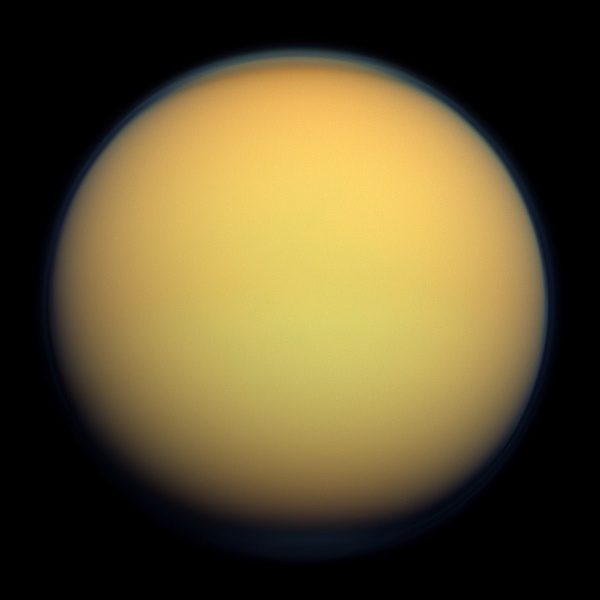We recently examined how and why Jupiter’s moon, Europa, could answer the longstanding question: Are we alone? While this small icy world gives plenty of reasons to believe why we could—and should—find life within its watery depths, it turns out our solar system is home to a myriad of places where we might find life. Much like how the Voyager missions gave us the first hints of an interior ocean swirling beneath Europa’s outer icy shell, it was only fitting that Voyager 1 also gave us the first hints of the potential for life on Saturn’s largest moon, Titan, as well.
Continue reading “Will Titan finally answer, ‘Are we alone?’”Whoa. Lakes on Titan Might be the Craters from Massive Underground Explosions
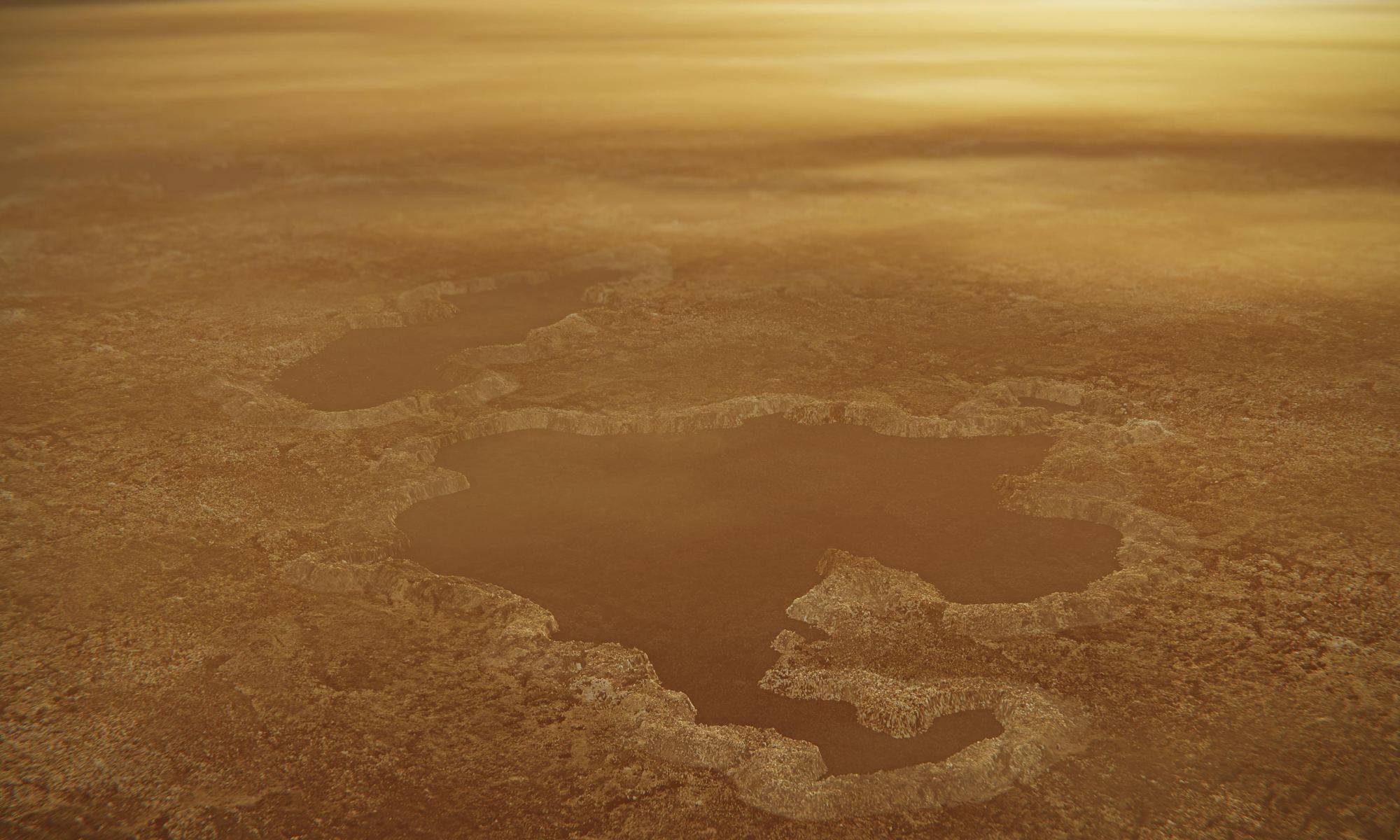
The Cassini spacecraft ended its mission to Saturn and its moons two years ago when it was sent plunging into Saturn to be destroyed. But after two years, scientists are still studying the data from the Cassini mission. A new paper based on Cassini data proposes a new explanation for how some lakes on Titan may have formed.
Continue reading “Whoa. Lakes on Titan Might be the Craters from Massive Underground Explosions”Enceladus is Filled with Tasty Food for Bacteria
As soon as the Cassini-Huygens mission arrived the Saturn system in 2004, it began to send back a number of startling discoveries. One of the biggest was the discovery of plume activity around the southern polar region of Saturn’s moon Enceladus’, which appears to be the result of geothermal activity and an ocean in the moon’s interior. This naturally gave rise to a debate about whether or not this interior ocean could support life.
Since then, multiple studies have been conducted to get a better idea of just how likely it is that life exists inside Enceladus. The latest comes from the University of Washington’s Department of Earth and Space Sciences (ESS), which shows that concentrations of carbon dioxide, hydrogen and methane in Enceladus’ interior ocean (as well as its pH levels) are more conducive to life than previously thought.
Continue reading “Enceladus is Filled with Tasty Food for Bacteria”Saturn’s Rings are Only 10 to 100 Million Years Old
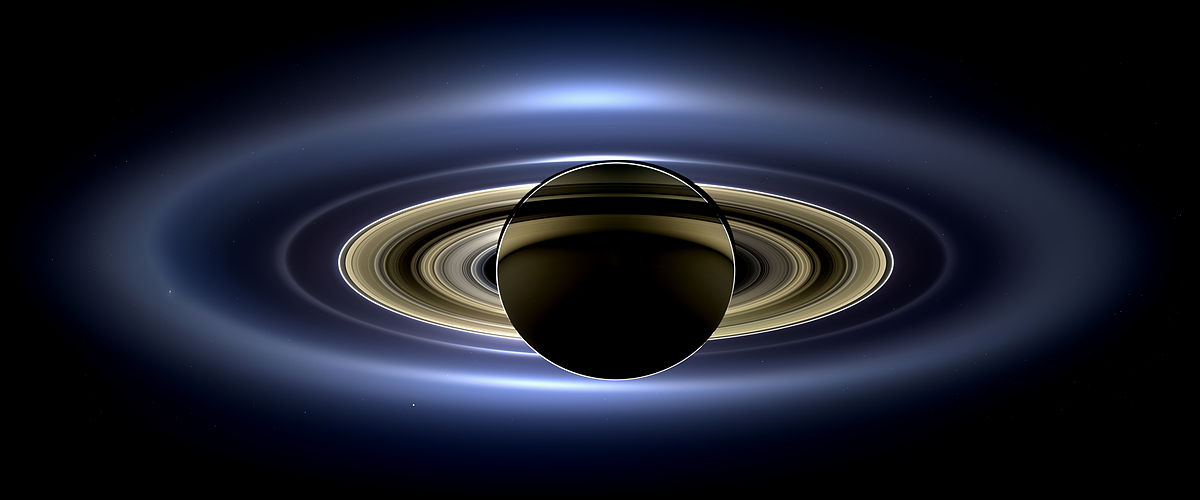
Can you imagine the Solar System without Saturn’s rings? Can you envision Earth at the time the dinosaurs roamed the planet? According to a new paper, the two may have coincided.
Data from the Cassini mission shows that Saturn’s rings may be only 10 to 100 million years old. They may not have been there during the reign of the dinosaurs, and may in fact be a fairly modern development in our Solar System.
Continue reading “Saturn’s Rings are Only 10 to 100 Million Years Old”Forecast for Titan: Cold, with a Chance of Noxious Ice Clouds
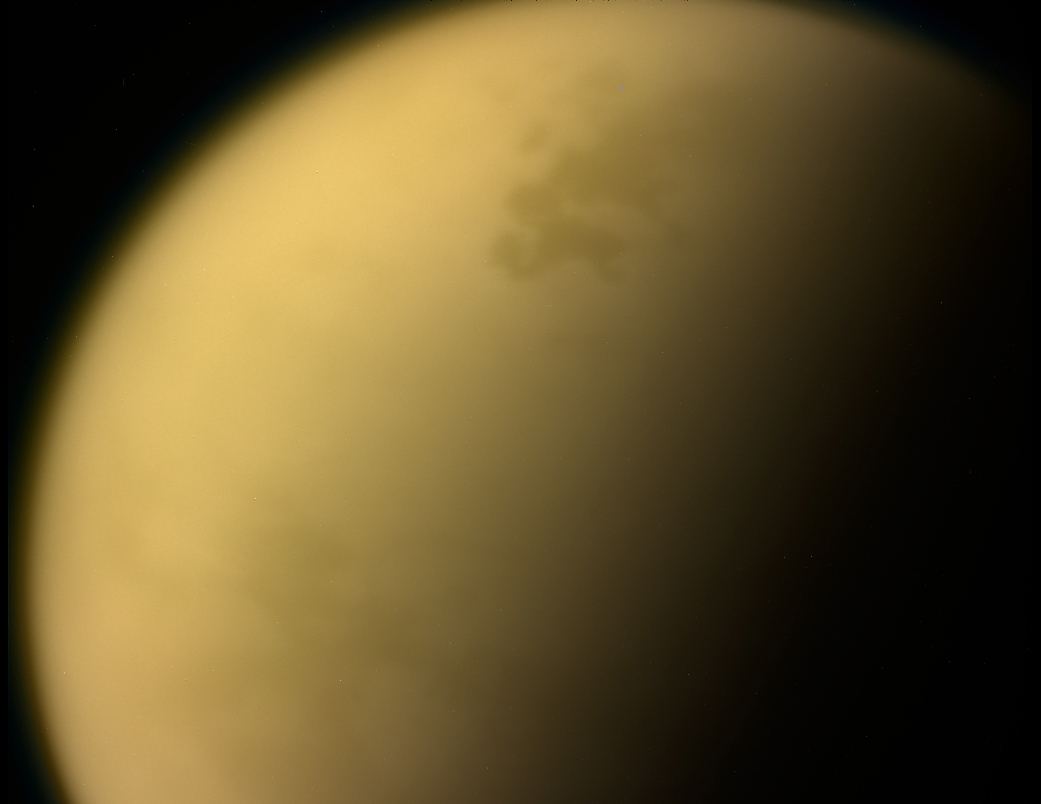
During the 13 years and 76 days that the Cassini mission spent around Saturn, the orbiter and its lander (the Huygens probe) revealed a great deal about Saturn and its systems of moons. This is especially true of Titan, Saturn’s largest moon and one of the most mysterious objects in the Solar System. As a result of Cassini’s many flybys, scientists learned a great deal about Titan’s methane lakes, nitrogen-rich atmosphere, and surface features.
Even though Cassini plunged into Saturn’s atmosphere on September 15th, 2017, scientists are still pouring over the things it revealed. For instance, before it ended its mission, Cassini captured an image of a strange cloud floating high above Titan’s south pole, one which is composed of toxic, hybrid ice particles. This discovery is another indication of the complex organic chemistry occurring in Titan’s atmosphere and on it’s surface.
Since this cloud was invisible to the naked eye, it was only observable thanks to Cassini’s Composite Infrared Spectrometer (CIRS). This instrument spotted the cloud at an altitude of about 160 to 210 km (100 to 130 mi), far above the methane rain clouds of Titan’s troposphere. It also covered a large area near the south pole, between 75° and 85° south latitude.
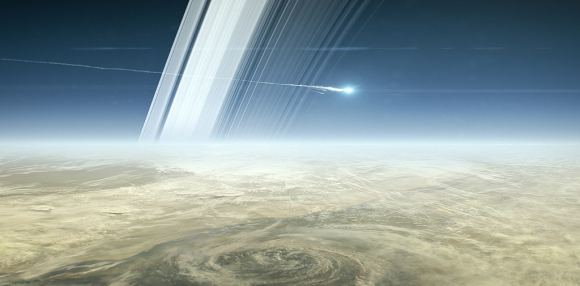
Using the chemical fingerprint obtained by the CIRS instrument, NASA researchers also conducted laboratory experiments to reconstruct the chemical composition of the cloud. These experiments determined that the cloud was composed of the organic molecules hydrogen cyanide and benzene. These two chemicals appeared to have condensed together to form ice particles, rather than being layered on top of each other.
For those who have spent more than the past decade studying Titan’s atmosphere, this was a rather interesting and unexpected find. As Carrie Anderson, a CIRS co-investigator at NASA’s Goddard Space Flight Center, said in a recent NASA press statement:
“This cloud represents a new chemical formula of ice in Titan’s atmosphere. What’s interesting is that this noxious ice is made of two molecules that condensed together out of a rich mixture of gases at the south pole.”
The presence of this cloud around Titan’s southern pole is also another example of the moon’s global circulation patterns. This involves currents of warm gases being sent from the hemisphere that is experiencing summer to the hemisphere experience winter. This pattern reverse direction when the seasons change, which leads to a buildup of clouds around whichever pole is experiencing winter.
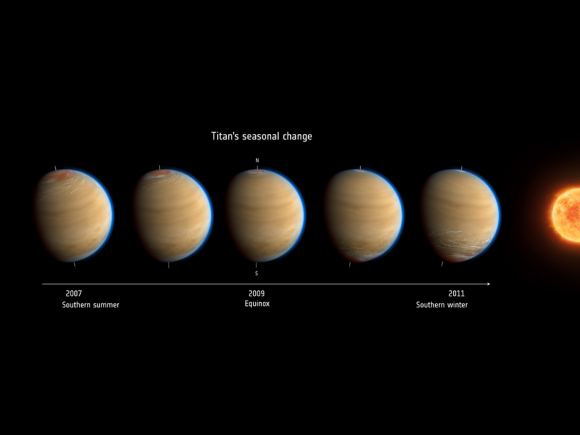
When the Cassini orbiter arrived at Saturn in 20o4, Titan’s northern hemisphere was experiencing winter – which began in 2004. This was evidenced by the buildup of clouds around its north pole, which Cassini spotted during its first encounter with the moon later than same year. Similarly, the same phenomena was taking place around the south pole near the end of Cassini’s mission.
This was consistent with seasonal changes on Titan, which take place roughly every seven Earth years – a year on Titan lasts about 29.5 Earth years. Typically, the clouds that form in Titan’s atmosphere are structured in layers, where different types of gas will condense into icy clouds at different altitudes. Which ones condense is dependent on how much vapor is present and temperatures – which become steadily colder closer to the surface.
However, at times, different types of clouds can form over a range of altitudes, or co-condense with other types of clouds. This certainly appeared to be the case when it came to the large cloud of hydrogen cyanide and benzene that was spotted above the south pole. Evidence of this cloud was derived from three sets of Titan observations made with the CIRS instrument, which took place between July and November of 2015.
The CIRS instrument works by separating infrared light into its constituent colors, and then measures the strengths of these signals at the different wavelengths to determine the presence of chemical signatures. Previously, it was used to identify the presence of hydrogen cyanide ice clouds over the south pole, as well as other toxic chemicals in the moon’s stratosphere.
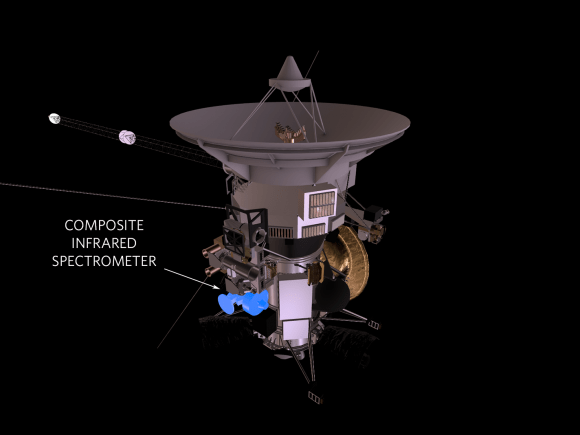
As F. Michael Flasar, the CIRS principal investigator at Goddard, said:
“CIRS acts as a remote-sensing thermometer and as a chemical probe, picking out the heat radiation emitted by individual gases in an atmosphere. And the instrument does it all remotely, while passing by a planet or moon.”
However, when examining the observation data for chemical “fingerprints”, Anderson and her colleagues noticed that the spectral signatures of the icy cloud did not match those of any individual chemical. To address this, the team began conducting laboratory experiments where mixtures of gases were condensed in a chamber that simulated conditions in Titan’s stratosphere.
After testing different pairs of chemicals, they finally found one which matched the infrared signature observed by CIRS. At first, they tried letting one gas condense before the other, but found that the best results were obtained when both gases were introduced and allowed to condense at the same time. To be fair, this was not the first time that Anderson and her colleagues had discovered co-condensed ice in CIRS data.
For example, similar observations were made near the north pole in 2005, about two years after the northern hemisphere experienced its winter solstice. At that time, the icy clouds were detected at a much lower altitude (below 150 km, or 93 mi) and showed chemical fingerprints of hydrogen cyanicide and caynoacetylene – one of the more complex organic molecules in Titan’s atmosphere.
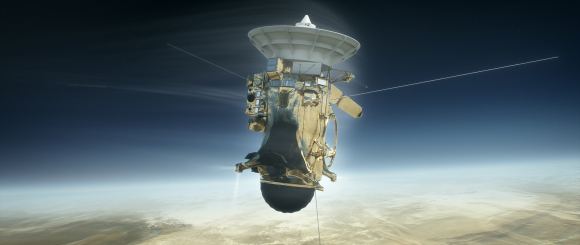
This difference between this and the latest detection of a hybrid cloud, according to Anderson, comes down to differences in seasonal variations between the north and south poles. Whereas the northern polar cloud observed in 2005 was spotted about two years after the northern winter solstice, the southern cloud Anderson and her team recently examined was spotted two years before the southern winter solstice.
In short, it is possible that the mixture of the gases was slightly different in the two case, and/or that the northern cloud had a chance to warm slightly, thus altering its composition somewhat. As Anderson explained, these observations were made possible thanks to the many years that the Cassini mission spent around Saturn:
“One of the advantages of Cassini was that we were able to flyby Titan again and again over the course of the thirteen-year mission to see changes over time. This is a big part of the value of a long-term mission.”
Additional studies will certainly be needed to determine the structure of these icy clouds of mixed composition, and Anderson and her team already have some ideas on how they would look. For their money, the researchers expect these clouds to be lumpy and disorderly, rather than well-defined crystals like the single-chemical clouds.
In the coming years, NASA scientists are sure to be spending a great deal of time and energy sorting through all the data obtained by the Cassini mission over the course of its 13-year mission. Who knows what else they will detect before they have exhausted the orbiter’s vast collections of data?
Future Reading: NASA
Cassini Conducts a Final Flyby of Titan Before Crashing into Saturn

When the Cassini spacecraft arrived around Saturn on July 1st, 2004, it became the fourth space probe to visit the system. But unlike the Pioneer 11 and Voyager 1 and 2 probes, the Cassini mission was the first to establish orbit around the planet for the sake of conducting long-term research. Since that time, the spacecraft and its accompanying probe – the Huygens lander – have revealed a startling amount about this system.
On Friday, September 15th, the Cassini mission will official end as the spacecraft descends into Saturn’s atmosphere. In part of this final maneuver, Cassini recently conducted one last distant flyby of Titan. This flyby is being referred to informally as “the goodbye kiss” by mission engineers, since it is providing the gravitational push necessary to send the spacecraft into Saturn’s upper atmosphere, where it will burn up.
In the course of this flyby, the spacecraft made its closest approach to Titan on Tuesday, September 12th, at 12:04 p.m. PDT (3:04 p.m. EDT), passing within 119,049 kilometers (73,974 mi) of the moon’s surface. The maneuver was designed to slow the probe down and lower the altitude of its orbit around the planet, which will cause it to descend into Saturn’s atmosphere in a few day’s time.
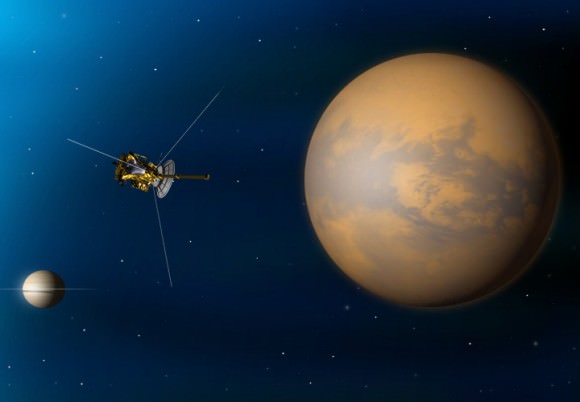
The flyby also served as an opportunity to collect some final pictures and data on Saturn’s largest moon, which has been a major focal point for much of the Cassini-Huygens mission. These will all be transmitted back to Earth at 18:19 PDT (21:19 EDT) when the spacecraft makes contact, and navigators will use this opportunity to confirm that Cassini is on course for its final dive.
All told, the spacecraft made hundreds of passes over Titan during its 13-year mission. These included a total of 127 precisely targeted encounters at close and far range (like this latest flyby). As Cassini Project Manager Earl Maize, from NASA’s Jet Propulsion Laboratory, said in a NASA press statement:
“Cassini has been in a long-term relationship with Titan, with a new rendezvous nearly every month for more than a decade. This final encounter is something of a bittersweet goodbye, but as it has done throughout the mission, Titan’s gravity is once again sending Cassini where we need it to go.”
In the course of making its many flybys, the Cassini spacecraft revealed a great deal about the composition of Titan’s atmosphere, its methane cycle (similar to Earth’s hydrological cycle) and the kinds of weather it experiences in its polar regions. The probe also provided high-resolution radar images of Titan’s surface, which included topography and images of its northern methane lakes.
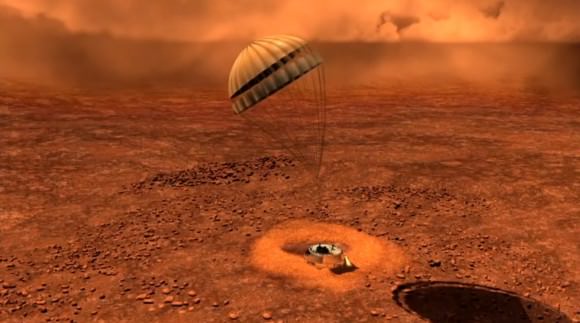
Cassini’s first flyby of Titan took place on July 2nd, 2004 – a day after the spacecraft’s orbital insertion – where it approached to within 339,000 km (211,000 mi) of the moon’s surface. On December 25th, 2004, Cassini released the Huygens lander into the planet’s atmosphere. The probe touched down on January 14th, 2005, taking hundreds of pictures of the moon’s surface in the process.
In November of 2016, the spacecraft began the Grand Finale phase of its mission, where it would make 22 orbits between Saturn and its rings. This phase began with a flyby of Titan that took it to the gateway of Saturn’s’ F-ring, the outermost and perhaps most active ring around Saturn. This was followed by a final close flyby of Titan on April 22nd, 2017, taking it to within 979 km (608 mi) of the moon’s surface.
Throughout its mission, Cassini also revealed some significant things about Saturn’s atmosphere, its hexagonal storms, its ring system, and its extensive system of moons. It even revealed previously-undiscovered moons, such as Methone, Pallene and Polydeuces. Last, but certainly not least, it conducted studies of Saturn’s moon Enceladus that revealed evidence of a interior ocean and plume activity around its southern polar region.
These discoveries are part of the reason why the probe will end its mission by plunging into Saturn’s atmosphere, about two days and 16 hours from now. This will cause the probe to burn up, thus preventing contamination of moons like Titan and Enceladus, where microbial life could possibly exist. Finding evidence of this life will be the main focus of future missions to the Saturn system, which are likely to launch in the next decade.
So long and best wishes, Cassini! You taught so much in the past decade and we hope to follow up on it very soon. We’ll all miss you when you go!
Further Reading: NASA
Titan’s Lakes are Nice and Calm. The Perfect Spot for a Landing
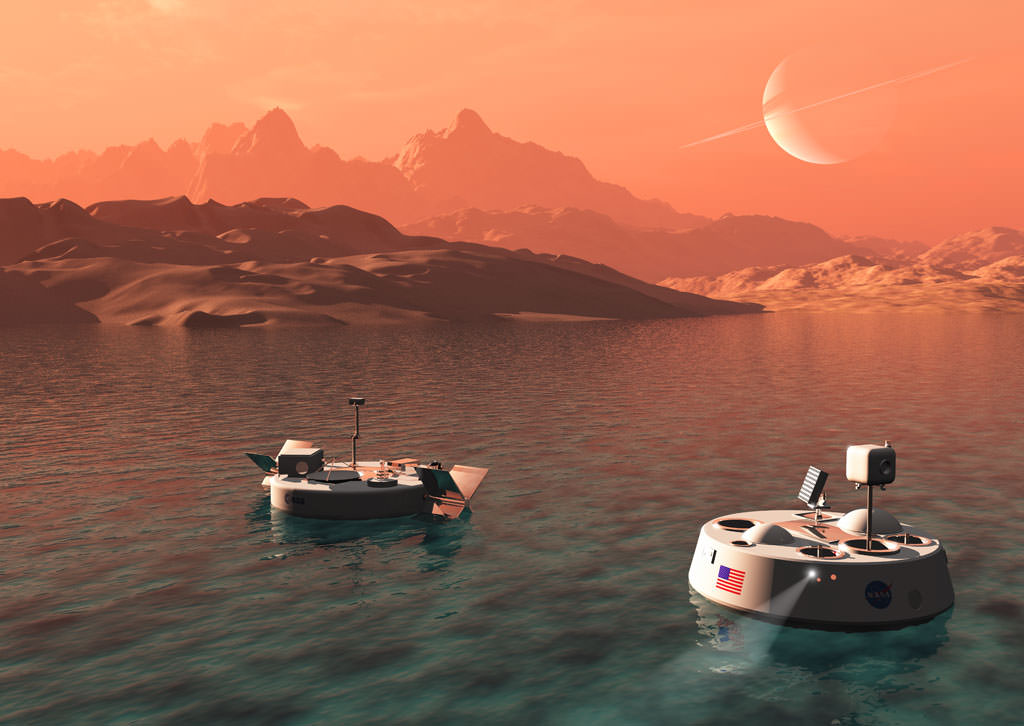
Ever since the Cassini orbiter and the Huygens lander provided us with the first detailed glimpse of Saturn’s moon Titan, scientists have been eager to mount new missions to this mysterious moon. Between its hydrocarbon lakes, its surface dunes, its incredibly dense atmosphere, and the possibility of it having an interior ocean, there is no shortage of things that are worthy of research.
The only question is, what form would this mission take (i.e. aerial drone, submarine, balloon, lander) and where should it set down? According to a new study led by the University of Texas at Austin, Titan’s methane lakes are very calm and do not appear to experience high waves. As such, these seas may be the ideal place for future missions to set down on the moon.
Their study, which was titled “Surface Roughness of Titan’s Hydrocarbon Seas“, appeared in the June 29th issue of the journal Earth and Planetary Science Letters. Led by Cyril Grima, a research associate at the University of Texas Institute for Geophysics (UTIG), the team behind the study sought to determine just how active the lakes are in Titan’s northern polar region are.
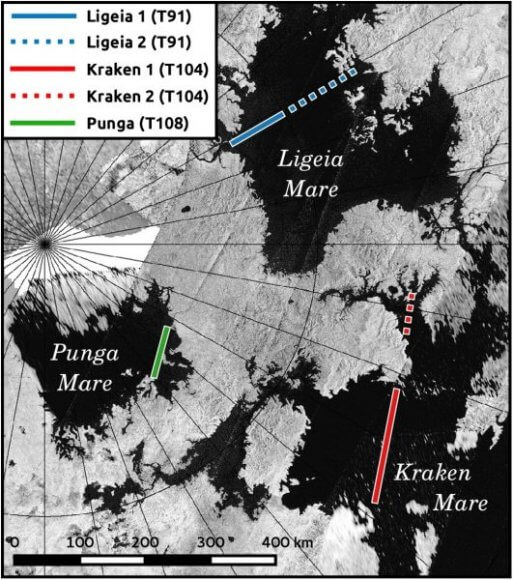
As Grima explained in a University of Texas press release, this research also shed light on the meteorological activity on Titan:
“There’s a lot of interest in one day sending probes to the lakes, and when that’s done, you want to have a safe landing, and you don’t want a lot of wind. Our study shows that because the waves aren’t very high, the winds are likely low.”
Towards this end, Grima and his colleagues examined radar data obtained by the Cassini mission during Titan’s early summer season. This consisted of measurements of Titan’s northern lakes, which included Ontario Lacus, Ligeia Mare, Punga Mare, and Kraken Mare. The largest of the three, Kraken Mars, is estimated to be larger than the Caspian Sea – i.e. 4,000,000 km² (1,544,409 mi²) vs 3,626,000 km2 (1,400,000 mi²).
With the help of the Cassini RADAR Team and researchers from Cornell University, the Johns Hopkins University Applied Physics Laboratory (JHUAPL), NASA’s Jet Propulsion Laboratory (JPL) and elsewhere, the team applied a technique known as radar statistical reconnaissance. Developed by Grima, this technique relies on radar data to measure the roughness of surfaces in minute detail.
This technique has also been used to measure snow density and the surface roughness of ice in Antarctica and the Arctic. Similarly, NASA has used the technique for the sake of selecting a landing site on Mars for their Interior Exploration using Seismic Investigations, Geodesy and Heat Transport (Insight) lander, which is scheduled to launch next year.
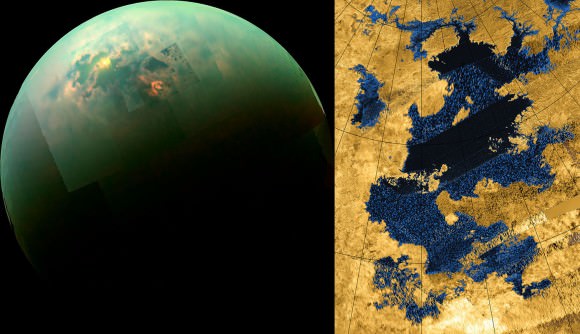
From this, Grima and his colleagues determined that waves on these lakes are quite small, reaching only 1 cm in height and 20 cm in length. These findings indicate that these lakes would be a serene enough environment that future probes could make soft landings on them and then begin the task of exploring the surface of the moon. As with all bodies, waves on Titan could be wind-driven, triggered by tidal flows, or the result of rain or debris.
As a result, these results are calling into question what scientists think about seasonal change on Titan. In the past, it was believed that summer on Titan was the beginning of moon’s windy season. But if this were the case, the results would have indicated higher waves (the result of higher winds). As Alex Hayes, an assistant professor of astronomy at Cornell University and a co-author on the study, explained:
“Cyril’s work is an independent measure of sea roughness and helps to constrain the size and nature of any wind waves. From the results, it looks like we are right near the threshold for wave generation, where patches of the sea are smooth and patches are rough.”
These results are also exciting for scientists who are hoping to plot future missions to Titan, especially by those who are hoping to see a robotic submarine sent to Titan’s to investigate its lakes for possible signs of life. Other mission concepts involve exploring Titan’s interior ocean, its surface, and its atmosphere for the sake of learning more about the moon’s environment, its organic-rich environment and probiotic chemistry.
And who knows? Maybe, just maybe, these missions will find that life in our Solar System is more exotic than we give it credit before, going beyond the carbon-based life that we are familiar with to include the methanogenic.
Further Reading: University of Texas JSG, Earth and Planetary Science Letters
Exploring Titan with Balloons and Landers

Last week – from Monday, February 27th to Wednesday, March 1st – NASA hosted the “Planetary Science Vision 2050 Workshop” at their headquarters in Washington, DC. In the course of the many presentations, speeches and panel discussions, NASA’s shared its many plans for the future of space exploration with the international community.
Among the more ambitious of these was a proposal to explore Titan using an aerial explorer and a lander. Building upon the success of the ESA’s Cassini-Huygen mission, this plan would involve a balloon that would explore Titan’s surface from low altitude, along with a Mars Pathfinder-style mission that would explore the surface.
Ultimately, the goal a mission to Titan would be to explore the rich organic chemical environment the moon has, which presents a unique opportunity for planetary researchers. For some time, scientists have understood that Titan’s surface and atmosphere have an abundance of organic compounds and all the prebiotic chemistry necessary for life to function.

The presentation, which was titled “Aerial Mobility : The Key to Exploring Titan’s Rich Chemical Diversity” was chaired by Ralph Lorenz from the Johns Hopkins Applied Physics Laboratory, and co-chaired by Elizabeth Turtle (also from John Hopkins APL) and Jason Barnes from the Dept. of Physics at the University of Idaho. As Turtle explained to Universe Today via email, Titan presents some exciting opportunities for a next-generation mission:
“Titan’s of particular interest because the abundant and complex organic chemistry can teach us about chemical interactions that could have occurred here on Earth (and elsewhere?) leading to the development of life. Furthermore, not only does Titan have an interior liquid-water ocean, but there will also have been opportunities for organic material to have mixed with liquid water at Titan’s surface, for example impact craters and possibly cryovolcanic eruptions. The combination of organic material with liquid water, of course, increases astrobiological potential.”
For this reason, the exploration of Titan has been a scientific goal for decades. The only question is how best to go about exploring Titan’s unique environment. During previous Decadal Surveys – such as the Campaign Strategy Working Group (CSWG) on Prebiotic Chemistry in the Outer Solar System, of which Lorenz was a contributor – has suggested that a mobile aerial vehicle (such as an airship or a balloon) would well-suited to the task.
However, such vehicles would be unable to study Titan’s methane lakes, which are one of the most exciting draws of the moon as far as research into prebiotic chemistry goes. What’s more, an aerial vehicle would not be able to conduct in-situ chemical analysis of the surface, much like what the Mars Exploration Rovers (Spirit, Opportunity and Curiosity) have been doing on Mars – and with immense results!
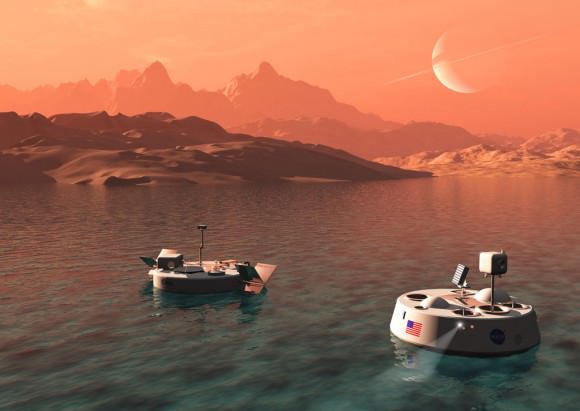
At the same time, Lorenz and his colleagues examined concepts for the exploration of Titan’s hydrocarbon seas – like the proposed Titan Mare Explorer (TiME) capsule. As one of several finalists of NASA’s 2010 Discovery competition, this concept called for the deployment of nautical robot to Titan in the coming decades, where it would study its methane lakes to learn more about the methane cycle and search for signs of organic life.
While such a proposal would be cost-effective and presents some very exciting opportunities for research, it also has some limitations. For instance, during the 2020s-2030s, Titan’s northern hemisphere will be experiencing its winter season; at which point the thickness of its atmosphere will make direct-to-Earth communications and Earth views impossible. On top of that, a nautical vehicle would preclude the exploration of Titan’s land surfaces.
These offer some of the most likely prospects for studying Titan’s advanced chemical evolution, including Titan’s dune sands. As a windswept region, this area likely has material deposited from all over Titan and may also contain aqueously altered materials. Much as the Mars Pathfinder landing site was selected so it could collect samples from a wide area, such as location would be an ideal site for a lander.
As such, Lorenz and his colleagues advocated the type of mission that was articulated in the 2007 Flagship Study, which called for a Montgolfière balloon for regional exploration and a Pathfinder-like lander. This would provide the opportunity to conduct surface imaging at resolutions that are impossible from orbit (due to the thick atmosphere) as well as investigating the surface chemistry and interior structure of the moon.
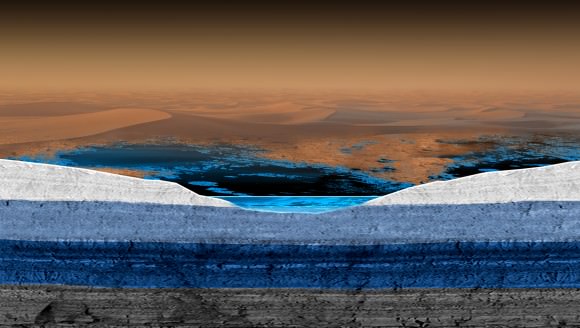
So while the balloon would gather high-resolution geographical data of the moon, the lander could conduct seismological surveys that would characterize the thickness of the ice above Titan’s internal water ocean. However, a lander mission would be limited in terms of range, and the surface of Titan presents problems for mobility. This would make multiple landers, or a relocatable lander, the most desired option.
“Potential targets include areas where we can measure solid surface materials, the composition of which is still not well known, Titan’s dune sands, for example,” said Turtle. “Detailed in situ analysis is required to determine their composition. The lakes and seas are also intriguing; however, in the nearer term (missions arriving in the 2030s) most of those will be in winter darkness. So, exploring them would likely have to wait until the 2040s.”
This mission concept would also take advantage of several technological advances that have been made in recent years. As Lorenz explained in the course of the presentation:
“Heavier-than-air mobility at Titan is in fact highly efficient, moreover, improvements in autonomous aircraft in the two decades since the CSWG make such exploration a realistic prospect. Multiple in-situ landers delivered by an aerial vehicle like an airplane or a lander with aerial mobility to access multiple sites, would provide the most desirable scientific capability, highly relevant to the themes of origins, workings, and life.”
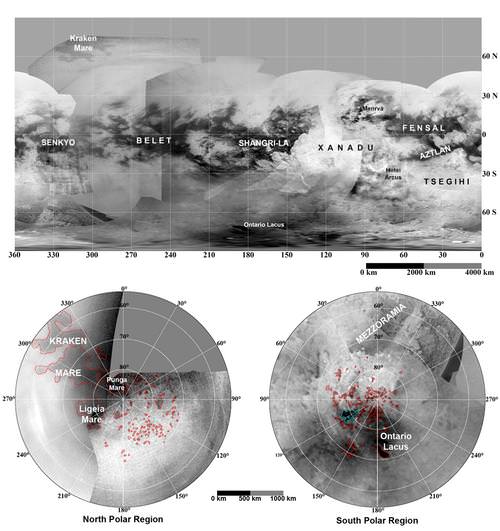
Lorenz, Turtle and Barnes will also be presenting these findings at the upcoming 48th Lunar and Planetary Science Conference – which will be taking place from March 20th to 24th in The Woodlands, Texas. There they will be joined by additional members of the Johns Hopkins APL and the University of Idaho, as well as panelists from NASA’s Goddard Space Flight Center, Pennsylvania State University, and Honeybee Robotics.
However, addressing some additional challenges not raised at the 2050 Vision Workshop, they will be presenting a slight twist on their idea. Instead of a balloon and multiple landers, they will present a mission concept involving a “Dragonfly” qaudcopter. This four-rotor vehicle would be able to take advantage of Titan’s thick atmosphere and low gravity to obtain samples and determine the surface composition in multiple geological settings.
This concept also incorporates a lot of recent advances in technology, which include modern control electronics and advances in commerical unmanned aerial vehicle (UAV) designs. On top of that, a quadcopter would do away with chemically-powered retrorockets and could power-up between flights, giving it a potentially much longer lifespan.
These and other concepts for exploring Saturn’s moon Titan are sure to gain traction in the coming years. Given the many mysteries locked away on this world – with includes abundant water ice, prebiotic chemistry, a methane cycle, and a subsurface ocean that is likely to be a prebiotic environment – it is certainly a popular target for scientific research.
Who was Giovanni Cassini?
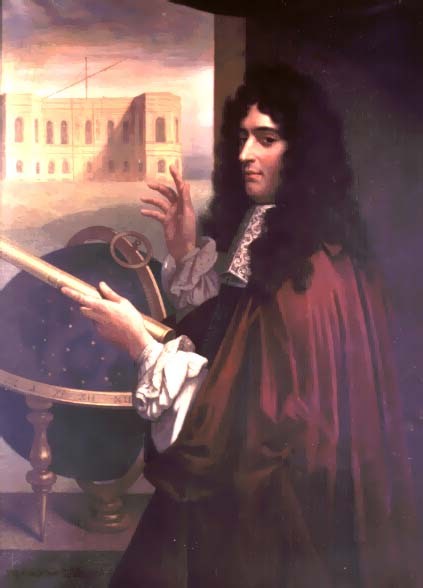
During the Scientific Revolution, which took place between the 15th and 18th centuries, numerous inventions and discoveries were made that forever changed the way humanity viewed the Universe. And while this explosion in learning owed its existence to countless individuals, a few stand out as being especially worthy of praise and remembrance.
One such individual is Gionvanni Domenico Cassini, also known by his French name Jean-Dominique Cassini. An Italian astronomer, engineer, and astrologer, Cassini made many valuable contributions to modern science. However, it was his discovery of the gaps in Saturn’s rings and four of its largest moons for which he is most remembered, and the reason why the Cassini spacecraft bears his name.
Early Life and Education:
Giovanni Domenico Cassini was born on June 8th, 1625, in the small town of Perinaldo (near Nice, France) to Jacopo Cassini and Julia Crovesi. Educating by Jesuit scientists, he showed an aptitude for mathematics and astronomy from an early age. In 1648, he accepted a position at the observatory at Panzano, near Bologna, where he was employed by a rich amateur astronomer named Marquis Cornelio Malvasia.
During his time at the Panzano Observatory, Cassini was able to complete his education and went on to become the principal chair of astronomy at the University of Bologna by 1650. While there, he made several scientific contributions that would have a lasting mark.

This included the calculation of an important meridian line, which runs along the left aisle of the San Petronio Basilica in Bologna. At 66.8 meters (219 ft) in length, it is one of the largest astronomical instruments in the worl and allowed for measurements that were (at the time) uniquely precise. This meridian also helped to settle the debate about whether or not the Universe was geocentric or heliocentric.
During his time in Italy, Cassini determined the obliquity of the Earth’s ecliptic – aka. it’s axial tilt, which he calculated to be 23° and 29′ at the time. He also studied the effects of refraction and the Solar parallax, worked on planetary theory, and observed the comets of 1664 and 1668.
In recognition of his engineering skills, Pope Clement IX employed Cassini with regard to fortifications, river management and flooding along the Po River in northern Italy. In 1663, Cassini was named superintendent of fortifications and oversaw the fortifying of Urbino. And in 1665, he was named the inspector for the town of Perugia in central Italy.
Paris Observatory:
In 1669, Cassini received an invitation by Louis XIV of France to move to Paris and help establish the Paris Observatory. Upon his arrival, he joined the newly-founded Academie Royale des Sciences (Royal Academy of Sciences), and became the first director of the Paris Observatory, which opened in 1671. He would remain the director of the observatory until his death in 1712.
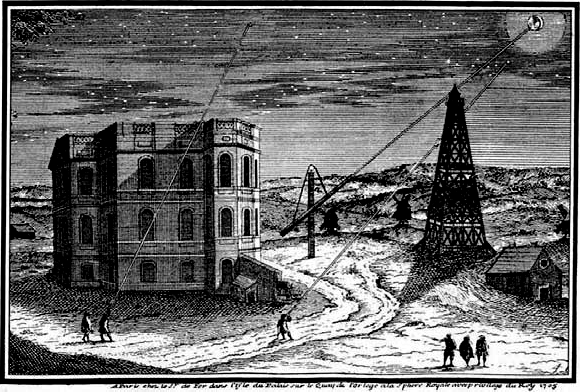
In 1673, Cassini obtained his French citizenship and in the following year, he married Geneviève de Laistre, the daughter of the lieutenant general of the Comte de Clermont. During his time in France, Cassini spent the majority of his time dedicated to astronomical studies. Using a series of very long air telescopes, he made several discoveries and collaborated with Christiaan Huygens in many projects.
In the 1670s, Cassini began using the triangulation method to create a topographic map of France. It would not be completed until after his death (1789 or 1793), when it was published under the name Carte de Cassini. In addition to being the first topographical map of France, it was the first map to accurately measure longitude and latitude, and showed that the nation was smaller than previously thought.
In 1672, Cassini and his colleague Jean Richer made simultaneous observations of Mars (Cassini from Paris and Richer from French Guiana) and determined its distance to Earth through parallax. This enabled him to refine the dimensions of the Solar System and determine the value of the Astronomical Unit (AU) to within 7% accuracy. He and English astronomer Robert Hooke share credit for the discovery of the Great Red Spot on Jupiter (ca. 1665).
In 1683, Cassini presented an explanation for “zodiacal light” – the faint glow that extends away from the Sun in the ecliptic plane of the sky – which he correctly assumed to be caused by a cloud of small particles surrounding the Sun. He also viewed eight more comets before his death, which appeared in the night sky in 1672, 1677, 1698, 1699, 1702 (two), 1706 and 1707.

In ca. 1690, Cassini was the first to observe differential rotation within Jupiter’s atmosphere. He created improved tables for the positions of Jupiter’s Galilean moons, and discovered the periodic delays between the occultations of Jupiter’s moons and the times calculated. This would be used by Ole Roemer, his colleague at the Paris Observatory, to calculate the velocity of light in 1675.
In 1683, Cassini began the measurement of the arc of the meridian (longitude line) through Paris. From the results, he concluded that Earth is somewhat elongated. While in fact, the Earth is flattened at the poles, the revelation that Earth is not a perfect sphere was groundbreaking.
Cassini also observed and published his observations about the surface markings on Mars, which had been previously observed by Huygens but not published. He also determined the rotation periods of Mars and Jupiter, and his observations of the Moon led to the Cassini Laws, which provide a compact description of the motion of the Moon. These laws state that:
- The Moon takes the same amount of time to rotate uniformly about its own axis asit takes to revolve around the Earth. As a consequence, the same face is always pointed towards Earth.
- The Moon’s equator is tilted at a constant angle (about 1°32′ of arc) to the plane of the Earth’s orbit around the Sun (i.e. the ecliptic)
- The point where the lunar orbit passes from south to north on the ecliptic (aka. the ascending node of the lunar orbit) always coincides with the point where the lunar equator passes from north to south on the ecliptic (the descending node of the lunar equator).
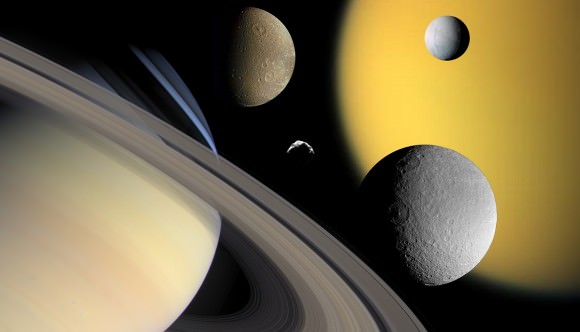
Thanks to his leadership, Giovanni Cassini was the first of four successive Paris Observatory directors that bore his name. This would include his son, Jaques Cassini (Cassini II, 1677-1756); his grandson César François Cassini (Cassini III, 1714-84); and his great grandson, Jean Dominique Cassini (Cassini IV, 1748-1845).
Observations of Saturn:
During his time in France, Cassini also made his famous discoveries of many of Saturn’s moons – Iapetus in 1671, Rhea in 167, and Tethys and Dione in 1684. Cassini named these moons Sidera Lodoicea (the stars of Louis), and correctly explained the anomalous variations in brightness to the presence of dark material on one hemisphere (now called Cassini Regio in his honor).
In 1675, Cassini discovered that Saturn’s rings are separated into two parts by a gap, which is now called the “Cassini Division” in his honor. He also theorized that the rings were composed of countless small particles, which was proven to be correct.
Death and Legacy:
After dedicating his life to astronomy and the Paris Observatory, Cassini went blind in 1711 and then died on September 14th, 1712, in Paris. And although he resisted many new theories and ideas that were proposed during his lifetime, his discoveries and contributions place him among the most important astronomers of the 17th and 18th centuries.

As a traditionalist, Cassini initially held the Earth to be the center of the Solar System. In time, he would come to accept the Solar Theory of Nicolaus Copernicus within limits, to the point that he accepted the model proposed by Tycho Brahe. However, he rejected the theory of Johannes Kepler that planets travel in ellipses and proposed hat their paths were certain curved ovals (i.e. Cassinians, or Ovals of Cassini)
Cassini also rejected Newton’s Theory of Gravity, after measurements he conducted which (wrongly) suggested that the Earth was elongated at its poles. After forty years of controversy, Newton’s theory was adopted after the measurements of the French Geodesic Mission (1736-1744) and the Lapponian Expedition in 1737, which showed that the Earth is actually flattened at the poles.
For his lifetime of work, Cassini has been honored in many ways by the astronomical community. Because of his observations of the Moon and Mars, features on their respective surfaces were named after him. Both the Moon and Mars have their own Cassini Crater, and Cassini Regio on Saturn’s moon Iapetus also bears his name.
Then there is Asteroid (24101) Cassini, which was discovered by C.W. Juels at in 1999 using the Fountain Hills Observatory telescope. Most recently, there was the joint NASA-ESA Cassini-Huygens missions which recently finished its mission to study Saturn and its moons. This robotic orbiter and lander mission was named in honor of the two astronomers who were chiefly responsible for discovering Saturn system of moons.
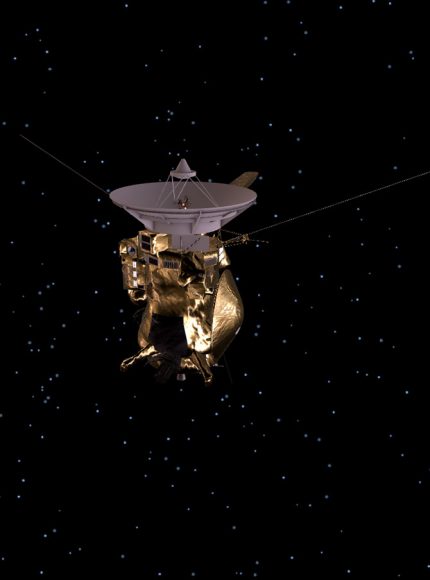
In the end, Cassini’s passion for astronomy and his contributions to the sciences have ensured him a lasting place in the annals of history. In any discussion of the Scientific Revolution and of the influential thinkers who made it happen, his name appears alongside such luminaries as Copernicus, Galileo, and Newton.
We have written many interesting articles about Giovanni Cassini here at Universe Today. Here’s How Many Moons Does Saturn Have?, The Planet Saturn, Saturn’s Moon Rhea, Saturn’s “Yin-Yang” Moon Iapetus, Saturn’s Moon Dione.
For more information, be sure to check out NASA’s Cassini-Huygens mission page, and the ESA’s as well.
Astronomy Cast also has some interesting episodes on the subject. Here’s Episode 229: Cassini Mission, and Episode 230: Christiaan Huygens.
Sources:
Life On Titan Possible Without Water
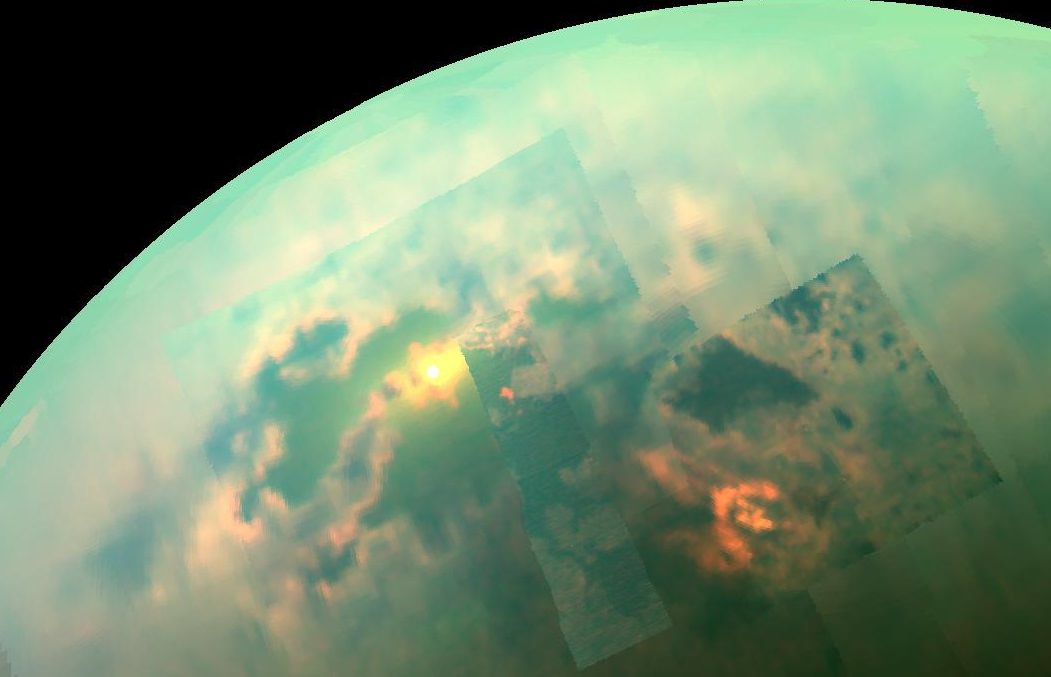
Saturn’s largest moon Titan is a truly fascinating place. Aside from Earth, it is the only place in the Solar System where rainfall occurs and there are active exchanges between liquids on the surface and fog in the atmosphere – albeit with methane instead of water. It’s atmospheric pressure is also comparable to Earth’s, and it is the only other body in the Solar System that has a dense atmosphere that is nitrogen-rich.
For some time, astronomers and planetary scientists have speculated that Titan might also have the prebiotic conditions necessary for life. Others, meanwhile, have argued that the absence of water on the surface rules out the possibility of life existing there. But according to a recent study produced by a research team from Cornell University, the conditions on Titan’s surface might support the formation of life without the need for water.
When it comes to searching for life beyond Earth, scientists focus on targets that possess the necessary ingredients for life as we know it – i.e. heat, a viable atmosphere, and water. This is essentially the “low-hanging fruit” approach, where we search for conditions resembling those here on Earth. Titan – which is very cold, quite distant from our Sun, and has a thick, hazy atmosphere – does not seem like a viable candidate, given these criteria.
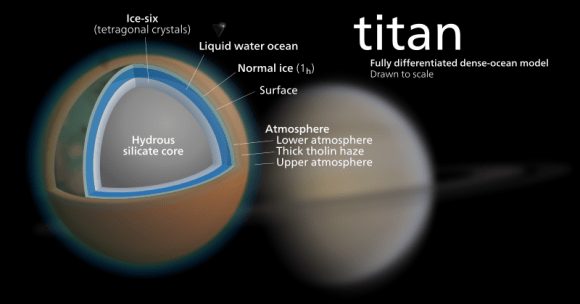
However, according to the Cornell research team – which is led by Dr. Martin Rahm – Titan presents an opportunity to see how life could emerge under different conditions, one which are much colder than Earth and don’t involve water.
Their study – titled “Polymorphism and electronic structure of polyimine and its potential significance for prebiotic chemistry on Titan” – appeared recently in the Proceedings of the National Academy of Sciences (PNAS). In it, Rahm and his colleagues examined the role that hydrogen cyanide, which is believed to be central to the origin of life question, may play in Titan’s atmosphere.
Previous experiments have shown that hydrogen cyanide (HCN) molecules can link together to form polyimine, a polymer that can serve as a precursor to amino acids and nucleic acids (the basis for protein cells and DNA). Previous surveys have also shown that hydrogen cyanide is the most abundant hydrogen-containing molecule in Titan’s atmosphere.
As Professor Lunine – the David C. Duncan Professor in the Physical Sciences and Director of the Cornell Center for Astrophysics and Planetary Science and co-author of the study – told Universe Today via email: “Organic molecules, liquid lakes and seas (but of methane, not water) and some amount of solar energy reaches the surface. So this suggests the possibility of an environment that might host an exotic form of life.”
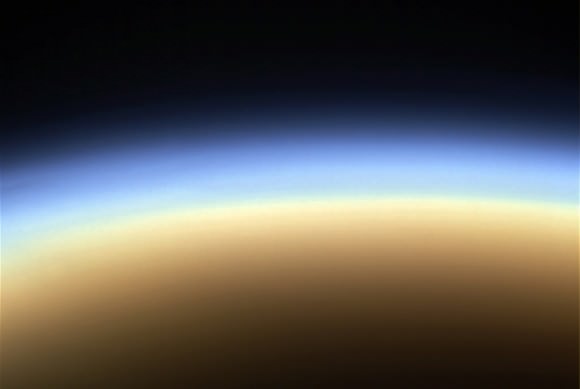
Using quantum mechanical calculations, the Cornell team showed that polyimine has electronic and structural properties that could facilitate prebiotic chemistry under very cold conditions. These involve the ability to absorb a wide spectrum of light, which is predicted to occur in a window of relative transparency in Titan’s atmosphere.
Another is the fact that polyimine has a flexible backbone, and can therefore take on many different structures (aka. polymorphs). These range from flat sheets to complex coiled structures, which are relatively close in energy. Some of these structures, according to the team, could work to accelerate prebiotic chemical reactions, or even form structures that could act as hosts for them.
“Polyimine can form sheets,” said Lunine, “which like clays might serve as a catalytic surface for prebiotic reactions. We also find the polyimine absorbs sunlight where Titan’s atmosphere is quite transparent, which might help to energize reactions.”
In short, the presence of polyimine could mean that Titan’s surface gets the energy its needs to drive photochemical reactions necessary for the creation of organic life, and that it could even assist in the development of that life. But of course, no evidence has been found that polyimine has been produced on the surface of Titan, which means that these research findings are still academic at this point.

However, Lunine and his team indicate that hydrogen cyanide may very well have lead to the creation of polyimine on Titan, and that it might have simply escaped detection because of Titan’s murky atmosphere. They also added that future missions to Titan might be able to look for signs of the polymer, as part of ongoing research into the possibility of exotic life emerging in other parts of the Solar System.
“We would need an advanced payload on the surface to sample and search for polyimines,” answered Lunine, “or possibly by a next generation spectrometer from orbit. Both of these are “beyond Cassini”, that is, the next generation of missions.”
Perhaps when Juno is finished surveying Jupiter’s atmosphere in two years time, NASA might consider retasking it for a flyby of Titan? After all, Juno was specifically designed to peer beneath a veil of thick clouds. They don’t come much thicker than on Titan!
Further Reading: PNAS

